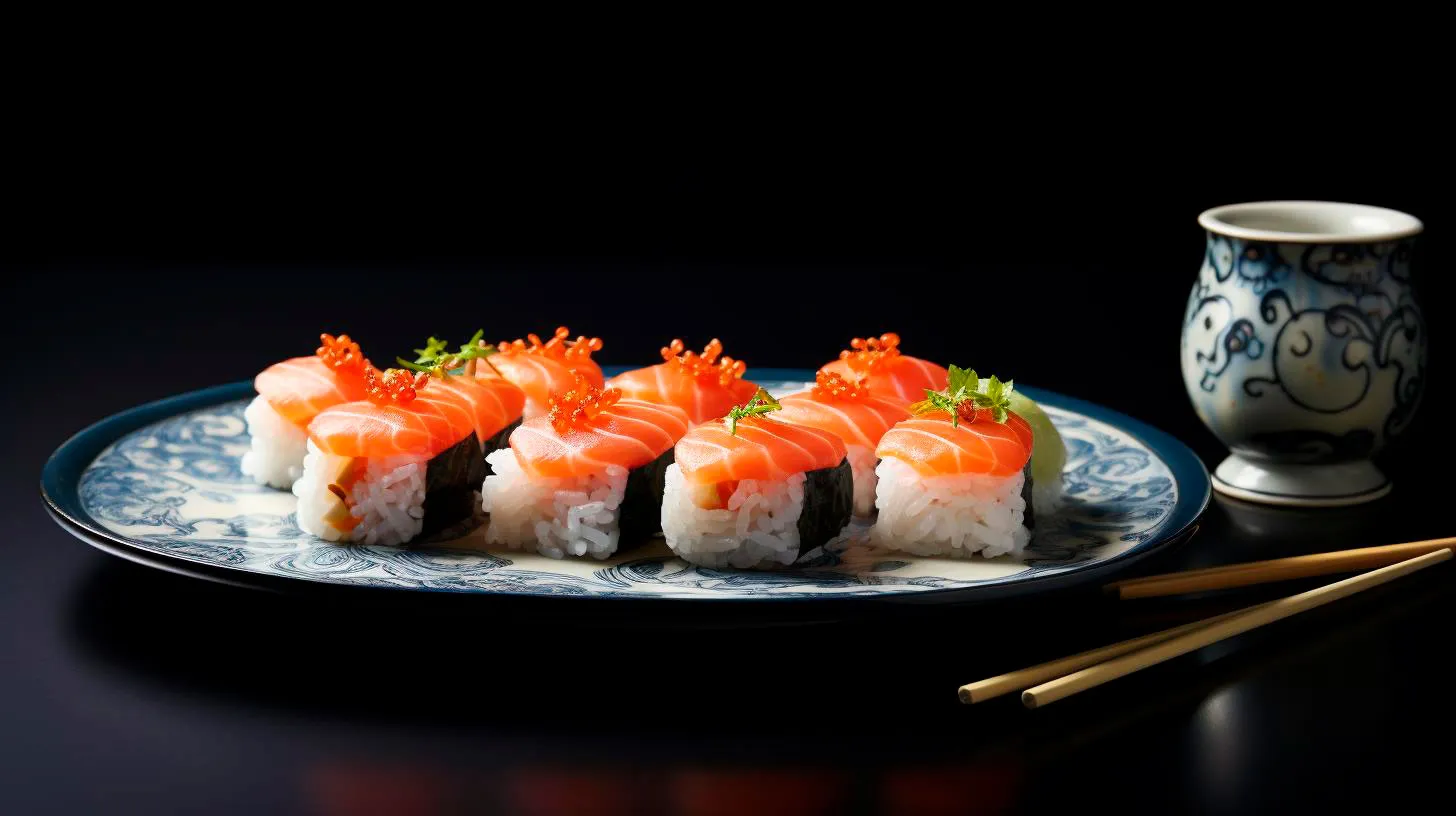Unraveling the Mystery Behind Fish Grades for Sushi
In this article, we will delve into the intricacies of fish grading for sushi, uncovering the mysteries and shedding light on what makes certain fish grades superior to others.
The Basics of Fish Grading
Before we dive deeper into the intricacies of fish grading for sushi, let’s first understand the basics. In general, fish grading relies on several key factors:
- Fish species
- Appearance
- Texture
- Color
- Fat content
- Origin
Now, let’s explore each of these factors in more detail.
1. Fish Species
The species of fish used for sushi can greatly influence its grade. Different species have distinct textures, flavors, and fat content, all of which contribute to the overall quality of the sushi. Some popular species used in sushi include tuna, salmon, yellowtail, and sea bream.
2. Appearance
The appearance of the fish plays a crucial role in determining its grade. Sushi chefs carefully inspect the fish for any flaws, such as bruises, blemishes, or discoloration. A fish with an impeccable appearance is more likely to receive a higher grade.
3. Texture
Texture is another important aspect considered during fish grading. The ideal fish for sushi should have a firm yet tender texture that melts in your mouth. A soft and mushy texture is usually an indication of poor quality.
4. Color
The color of the fish can reveal a lot about its freshness and quality. For example, bright red tuna is often considered superior, while pale or discolored flesh is indicative of a lower grade. A vibrant and consistent color is desirable in sushi-grade fish.
5. Fat Content
The amount of fat in the fish, particularly the marbling within the flesh, significantly affects its grade. A higher fat content generally indicates a more flavorful and tender fish, making it a preferred choice for sushi.
6. Origin
The origin of the fish can also influence its grade. Sushi chefs often prioritize fish that are sourced from reputable fishing regions known for their high-quality seafood. For example, fish caught in Japan’s Tsukiji Market, considered the world’s largest fish market, are highly sought after.
Why Does Fish Grade Matter?
Now that we understand the factors used in fish grading for sushi, let’s explore why it’s important.
1. Quality Assurance: Fish grading ensures that only the finest and freshest fish make it onto your sushi plate. The grading process helps eliminate fish that don’t meet the strict criteria set by sushi chefs, guaranteeing a superior dining experience.
2. Flavor and Texture: The grade of the fish directly impacts the flavor and texture of the sushi. Higher-grade fish are known for their exquisite taste, tenderness, and melt-in-your-mouth experience. When you choose sushi made with top-grade fish, you can expect an unforgettable culinary journey.
3. Safety: Ensuring the fish used in sushi is of high quality is essential for your health and safety. High-grade fish are carefully handled, stored, and prepared, minimizing the risk of foodborne illnesses or contamination.
Key Takeaways
As a sushi enthusiast, understanding the grading process of fish used in sushi provides valuable insights into the quality and freshness of the dishes you love. Here are the key takeaways from this article:
- Fish grading involves assessing various factors such as species, appearance, texture, color, fat content, and origin.
- Species, appearance, texture, and color contribute to the overall grade of the fish.
- Fish with higher fat content and sourced from reputable regions often receive higher grades.
- Fish grading ensures quality, enhances flavor and texture, and promotes safety.
Next time you savor a piece of sushi, take a moment to appreciate the intricate process behind fish grading. The dedication of sushi chefs to deliver the finest quality sushi is truly remarkable. Enjoy your sushi experience, knowing that every bite has been carefully crafted to delight your taste buds!
Mastering Fish Grades: The Key to Perfect Sushi
In this article, we will delve into the world of fish grades, explore their significance, and provide insights into how you can master this art.
Why are Fish Grades Important?
Fish grades serve as a scale to determine the quality of the fish used in sushi preparation. They help sushi chefs and consumers identify whether the fish is suitable for consumption raw or requires further cooking to enhance taste and texture. By considering fish grades, you can ensure that your sushi is not only safe to eat but also brings out the flavors in the best possible way.
Understanding Fish Grading Systems
Various grading systems exist worldwide, but the most common ones used in the sushi industry are the Japanese grading system and the American Seafood Inspection Program. Let us take a closer look at these two systems.
Japanese Grading System
The Japanese grading system primarily focuses on visual appearance, texture, and fat content of the fish. It assigns a grade from the highest quality to the lowest, with the top grade being “sashimi” or “sushi” grade. Here are the most common fish grades used in the Japanese system:
- Sashimi Grade (A+): The best quality fish available, particularly suitable for raw consumption in sushi.
- Sushi Grade (A): High-quality fish that is fresh and suitable for sushi.
- Regular Grade (B or C): Fish with a lower fat content or less visual appeal, often used for cooked or seasoned dishes.
American Seafood Inspection Program
The American grading system, managed by the National Marine Fisheries Service, focuses on the overall quality, freshness, and handling of the fish. It provides certifications such as “U.S. Grade A” or “U.S. Grade B” based on these criteria. However, this grading system is not as widely used in sushi restaurants compared to the Japanese system.
Tips for Choosing the Best Fish for Sushi
Now that we understand the significance of fish grades, let’s explore some essential tips to help you choose the best fish for your sushi:
- Buy from reputable sources: Purchase fish from trusted seafood markets or suppliers known for their high-quality products. Freshness is key.
- Check for transparency: The skin should be transparent and shiny, gills should be bright red or pink, and the flesh should be firm.
- Assess smell: Fresh fish should have a mild, oceanic smell. Avoid any fish with a strong ammonia-like odor.
- Look for vibrant color: The color of the fish should be appealing and not faded. Each type of fish should have its characteristic color.
- Consider fatty fish: For an enhanced taste experience, choose fatty fish like salmon or tuna that will bring richness to your sushi.
Key Takeaways
Mastering fish grades is essential for creating the perfect sushi experience. By understanding the different grading systems, such as the Japanese and American systems, you can confidently choose and appreciate the quality of the fish you’re using. Here are the key takeaways from this article:
- Fish grades determine the quality and suitability of fish for sushi consumption.
- The Japanese grading system, focused on visual appearance and fat content, is primarily used in sushi restaurants.
- The American grading system is less widely used in sushi restaurants.
- Tips for choosing the best fish include buying from reputable sources, checking for transparency and freshness, assessing smell, and considering fatty fish for enhanced flavor.
Next time you indulge in sushi, remember the importance of fish grades in elevating your dining experience. With these insights in hand, you are now equipped to become a true connoisseur of sushi and create your own delicious masterpieces!
Cracking the Code: Fish Grading System Unveiled
The Importance of Fish Grading
Before we delve into the nitty-gritty details, let’s understand why fish grading is crucial. As consumers, we are constantly seeking the highest quality produce, and seafood is no exception. Fish grading helps us make informed choices by providing an objective measure of the fish’s quality, freshness, and overall value.
With that said, let’s take a closer look at how the fish grading system works and what these grades actually mean.
The Three Fish Grades Explained
1. AAA Grade
- AAA grade fish is the crème de la crème of seafood.
- It represents the highest quality and is usually reserved for fish that meets stringent criteria in terms of freshness, appearance, and taste.
- AAA grade fish is generally caught or harvested using sustainable fishing practices, ensuring minimal impact on the environment.
2. AA Grade
- AA grade fish is still of excellent quality, but falls just short of the pristine standards set by AAA grade.
- These fish may have minor imperfections in appearance or slightly less flavor intensity, but are still highly desirable.
- AA grade fish is an excellent choice for those looking for top-notch seafood within a slightly more affordable price range.
3. A Grade
- A grade fish represents good quality seafood that meets the industry’s acceptable standards.
- While it may not possess the premium attributes of AAA or AA grade fish, A grade fish is still fresh and delicious.
- It offers a more budget-friendly option for consumers without compromising on taste.
The Grading Process
The grading process for fish involves a meticulous evaluation of various factors carried out by experts in the industry. These factors include:
- Visual Appearance: Evaluating the fish’s color, texture, and overall condition.
- Freshness: Assessing the smell, firmness, and moisture content of the fish.
- Size: Determining the size and weight, which may influence the grading outcome.
- Source and Sustainability: Considering the fishing methods used and the fish’s origin, ensuring ethical and eco-friendly practices are followed.
By analyzing these key aspects, graders assign the appropriate grade to each fish, ensuring consumers can make informed choices based on their preferences and needs.
The Benefits of Fish Grading
Understanding the fish grading system offers several advantages:
- Quality Assurance: Fish grading assures consumers of the fish’s quality, freshness, and flavor, allowing them to purchase with confidence.
- Price Differentiation: Grades provide a pricing structure, offering options for consumers across various budgets.
- Sustainability: By considering the source and fishing methods, seafood enthusiasts can support sustainable practices and protect marine ecosystems.
- Enhanced Culinary Experience: Higher grade fish often deliver superior taste and texture, providing an elevated dining experience for seafood aficionados.
In Conclusion
Next time you find yourself browsing the seafood section of your local grocery store or ordering from a fish market, keep an eye out for those fish grades. The fish grading system ensures you get the best possible seafood experience, whether you opt for the highest quality AAA grade, the value-packed AA grade, or the wallet-friendly A grade fish.
By cracking the code of the fish grading system, you can make informed choices, support sustainability, and indulge in delicious seafood that meets your expectations. So, go ahead, explore the wide array of fish grades available, and elevate your culinary adventures!
Decoding Fish Grades for Sushi Excellence
One crucial factor that determines the quality of sushi is the grade of fish used. Understanding fish grades is essential for both sushi chefs and sushi enthusiasts to ensure an exceptional dining experience.
The Importance of Fish Grades
Fish grades provide a standardized rating system that helps identify the quality, freshness, and taste of fish. The grading system ensures that sushi chefs and consumers can make informed choices when selecting fish for their dishes. The grading system is particularly crucial for raw fish, as cooking can sometimes mask the quality of the fish in cooked dishes.
Grades for sushi fish may vary depending on the country or region, but the following are some commonly recognized grades:
- Grade A – The highest grade, indicating exceptional quality and freshness.
- Grade B – Good quality fish suitable for sushi.
- Grade C – Lower-grade fish usually used for cooked dishes.
- Grade D – The lowest grade, often reserved for fish that is past its prime.
Understanding these grades can help sushi lovers make informed choices and ensure they are getting the best quality fish for their sushi.
Determining Fish Grades
Several factors contribute to determining the grade of fish for sushi:
Appearance and Color
The appearance and color of the fish can indicate its freshness and overall quality. Grade A fish will have vibrant colors, clear eyes, and shiny skin, indicating freshness. Dull colors, cloudy eyes, or discolored skin may be signs of lower-grade fish.
Texture and Firmness
The texture and firmness of the fish are also important indicators of its grade. Grade A fish will have a firm texture and bounce-back when touched. Sushi-grade fish should have a silky-smooth texture, indicating freshness and tenderness.
Scent
The scent of the fish can provide insights into its quality. Grade A fish will have a clean, oceanic scent, while lower-grade fish may have a strong or fishy odor.
Origin and Handling
The origin and handling of the fish can also impact its grade. Fish sourced from reputable suppliers and handled with care are more likely to have higher grades. Proper temperature control during transportation and storage is crucial to maintaining fish quality.
Key Takeaways
- Fish grades are essential for determining the quality of fish used in sushi.
- Grade A fish indicates exceptional quality and freshness.
- Grade B fish is suitable for sushi but may lack some characteristics of Grade A fish.
- Grade C and Grade D fish are typically used for cooked dishes.
- Factors such as appearance, color, texture, scent, and handling techniques contribute to determining fish grades.
- Understanding fish grades helps sushi lovers choose the best quality fish for their sushi creations.
Next time you visit your favorite sushi restaurant or consider preparing sushi at home, be sure to keep fish grades in mind. By decoding these grades, you’ll have a better understanding of the quality and freshness of the fish you’re about to enjoy. Embrace the art of sushi and elevate your culinary experience by selecting the finest fish for your next sushi masterpiece!


